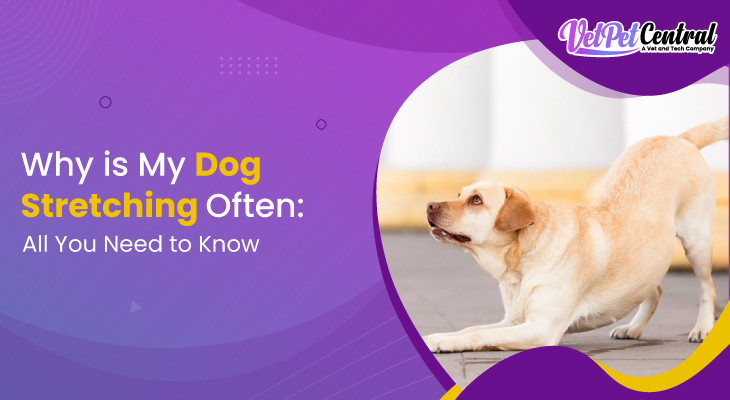Why is My Dog Stretching Often: All You Need to Know.
 Jan 21, 2025
Jan 21, 2025

Every dog owner wishes that their furry friend lives at best. Whatever it costs them, they ensure a calm and healthy relationship with dog companions by providing quality space, food, and company.
Like humans, dogs also need stretching exercises to be flexible, avoid injuries, and always be in good health.
This comprehensive dog stretching guide will outline the various stretches that will help to target each part of the muscle group, such as the neck, shoulders, back, hips, & legs.
Furthermore, you’ll find out how to safely stretch your furry fellow.
Keep reading to get insights into all about dog stretching!
Why Does My Dog Stretch So Much?
You may wonder why your dog stretching a lot. Well, there can be several reasons, including:
To relieve muscle tension
If your dog has been active, it may stretch to relieve muscle tension.
This is especially common in dogs participating in high-impact activities like running or jumping.
This helps to wake them up and prepare them for activity.
To wake up and get ready
Just like humans, dogs need to stretch their muscles and get their blood flowing in the morning.
To improve circulation
Stretching helps to improve circulation by increasing blood flow to the muscles.
This prevents muscle soreness and fatigue in dogs.
To communicate
Dogs can use stretching to communicate with other dogs and humans.
For example, a dog might stretch in front of another dog to show submission or initiate play.
To feel good
Stretching simply feels good for dogs. They get relaxed and release endorphins, which have mood-boosting effects.
To mark their territory
When dogs stretch, they may leave behind scent molecules from their paws.
This means marking their territory and letting other dogs know they have been there.
To prepare for a meal
Some dogs stretch before they eat.
This may be a way to help them digest their food or to get comfortable before they start eating.
To signal pain
Rarely, dogs may exhibit excessive stretching as a pain signal.
If you observe that your dog is stretching more than normal, take it to the veterinarian to rule out any medical issues.
Types of Dog Stretches
Stretching plays a vital role in keeping our canine companions healthy and agile. This will help you understand the importance of incorporating these stretches into your dog's daily routine. Let’s explore different types of dog stretches.
Front Leg Stretches for Dogs
The front legs of dogs bear a significant portion of their weight and are essential for mobility. Here are three major front leg stretches in dogs;
1) Shoulder Stretch
- Improves the range of motion and prevents stiffness
- Focuses on the muscles surrounding the shoulder joint
- Gently extend your dog's front leg forward and support the dog's weight
- Hold the stretch for 10-15 seconds
2) Wrist Stretch:
- Targets the muscles and tendons of the wrist joint
- Helps improve flexibility
- Useful for active dogs
- Extend your dog's front leg backward, bending at the wrist joint
- And hold the stretch for a few seconds.
3) Elbow Stretch
- Targets the muscles and tendons around the dog’s elbow joint
- Enhances flexibility and can be effective for elbow issues
- Softly flex your dog's front leg at the elbow joint
- Holding the stretch for 10-15 seconds
Back Leg Stretches
The back legs of a dog are responsible for propulsion and stability. Here are three important back leg dogs stretching;
1) Hip Stretch
- The hip stretch aims at the muscles surrounding the hip joint
- It assists in maintaining a dog’s hip mobility and prevents tightness
- To perform this exercise for your dog, rotate its back leg outward from the hip joint
- Hold the stretch for 10-15 seconds
2) Knee Stretch
- This type of stretch is for the muscles and ligaments around the knee joint
- It improves flexibility and can be beneficial for dogs with knee issues
- You can flex your dog's back leg at the knee joint
- Holding the stretch for 10-15 seconds
3) Hock Stretch
- The hock stretches target the muscles and tendons of the hock joint (the equivalent of a human ankle)
- It is for enhancing flexibility and is particularly useful for active dogs
- This type of dog stretch can be done easily by extending its back leg forward, bending at the hock joint
- Hold the stretch for 10-15 seconds
4) Neck Stretches
In dogs, there are four essential neck stretches, including:
Chin to Chest Stretch
- Helps release tension in the dog’s neck muscles
- Improves flexibility
- Gently encourage your dog to lower its head towards its chest
- Hold the stretch for 10-15 seconds
- Incorporate this stretch into your dog's daily routine to maintain neck health and prevent stiffness
Head Tilt
- Focuses on the muscles that allow your dog to tilt their head
- Improves the range of motion and can benefit dogs with neck discomfort
- Gently guide your dog's head to one side, tilting it slightly
- Hold the stretch for a few seconds. Repeat on the other side
- Perform this stretch after long periods of rest or inactivity to ease any built-up tension
Ear to Shoulder Stretch
- Targets the muscles on the side of the neck and enhances mobility
- Guide your dog's head to one side, encouraging their ear to touch their shoulder
- Hold the stretch for 10-15 seconds. Repeat on the other side
- Use treats or toys to guide your dog's head into the stretch gently
Nose-to-Shoulder Stretch
- Aims to stretch the muscles along the side of the neck and upper back
- Gently guide your dog's nose towards its shoulder
- Hold the stretch for 10-15 seconds. Repeat on the other side
- This stretch can be beneficial for senior dogs to help maintain neck
Whole-Body Stretches
Whole-body stretches engage multiple muscle groups simultaneously and promote overall flexibility and well-being. Here are three important whole-body dog stretches;
1) Twisting Stretch
- Targets the spine and helps improve spinal mobility in dogs
- Guide your dog's head in one direction while guiding its back end in the opposite direction
- Create a gentle twist through its body and repeat on the other side
- This stretch can help alleviate stiffness and tension in the spine, especially for older dogs
2) Downward Dog Stretch
- Mimics the yoga pose and elongates the entire body
- Encourage your dog to stretch its front legs forward and its back legs backward, forming an inverted V-shape
- Hold the stretch for a few seconds
- This stretch is great for warming up your dog before a walk or playtime
- It promotes blood flow and flexibility
3) Play Bow Stretch
- Involves the dog lowering its front legs and chest to the ground while keeping its rear end up
- This stretch is often a natural part of a dog’s play behavior
- It helps stretch the muscles of the back, hips, and shoulders
- Incorporate this stretch into play sessions to keep your dog limber and reduce the risk of muscle strains
If you're curious about other typical dog behaviors, check out our blog on why the dog pants at night.
How to Stretch Your Dog Safely
It is essential to approach dog stretching cautiously and ensure it is done safely to prevent any potential harm. Let’s learn about important guidelines and techniques for safely stretching your dog.
Warming Up Your Dog
Before engaging in any stretching exercises, it is crucial to warm up your dog's muscles to prepare them for movement. A proper warm-up helps prevent injuries and allows for a more effective stretching session.
For that, consider the following tips:
- Start with a brisk walk or gentle jog to increase blood flow and warm up your dog’s muscles.
- Incorporate some basic exercises such as sit, down, and stand to engage different muscle groups.
- Use interactive toys or play fetch to encourage movement and elevate the heart rate slightly.
Warming up your dog prepares its body for stretching and reduces the risk of strains or sprains.
Communicating with Your Dog
Effective communication is key during dog stretching to ensure your puppy feels comfortable and safe. Consider the essential points below:
- Use strategies like praise, food, and gentle caressing to effectively establish a relationship between stretching and positive reward.
- Stretch your dog gently at first, then progressively increase the intensity as they grow more supple and comfortable.
- Observe the cues and body language your dog uses. If your dog exhibits any symptoms of discomfort or resistance, modify the stretch or stop altogether.
- Shorten the stretching periods at first, and as your dog becomes used to the schedule, lengthen them progressively.
- You may create a nice stretching experience for your dog by communicating clearly with them.
Through clear communication with your dog, you can create a positive stretching experience.
Avoiding Pushing Too Far
While dog stretching is beneficial, avoiding pushing your dog beyond its limits is crucial. The reason is pushing too far can lead to injuries and cause your dog to associate stretching with discomfort or pain.
Consider the following guidelines:
- Consider the specific restrictions that apply to your dog and modify the stretches accordingly. Keep in mind that every dog is different, so what suits one might not suit another.
- If your dog refuses to stretch or exhibits pain, don't force the stretch. It is preferable to take a step back, attempt a different stretch, or speak with a vet.
- Stretches should be done longer and more intensely gradually so that your dog's body can adjust and become more flexible on its own.
Avoiding Pain
One of the primary goals of dog stretching is to enhance your dog's flexibility and well-being, not to cause pain or discomfort.
So, to avoid pain during stretching sessions, keep the following in mind:
- Always use gentle and controlled movements during stretches
- Do not stretch injured or inflamed areas of your dog's body
- If you notice any signs of distress in your dog, stop the stretch immediately and seek guidance from a professional
Wrapping Up!
There can be many reasons for dog stretching, and there are several ways to help your dog stretch the different parts of the body. But—all should go gently and carefully.
At VetPet Central, pet owners can learn and find the best veterinarian in their closest area to treat their dog’s health and take expert consultation. We connect you to top veterinarians, animal hospitals, and veterinary clinics for smooth online appointments.
We aim to bridge the gap between pet parents and animal health care professionals to make canine health more accessible.






